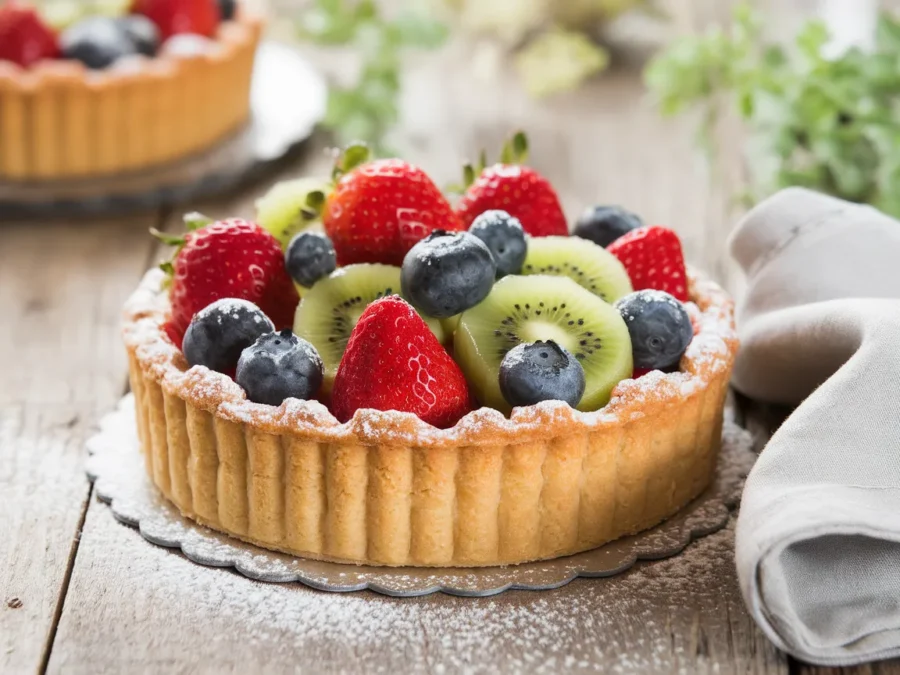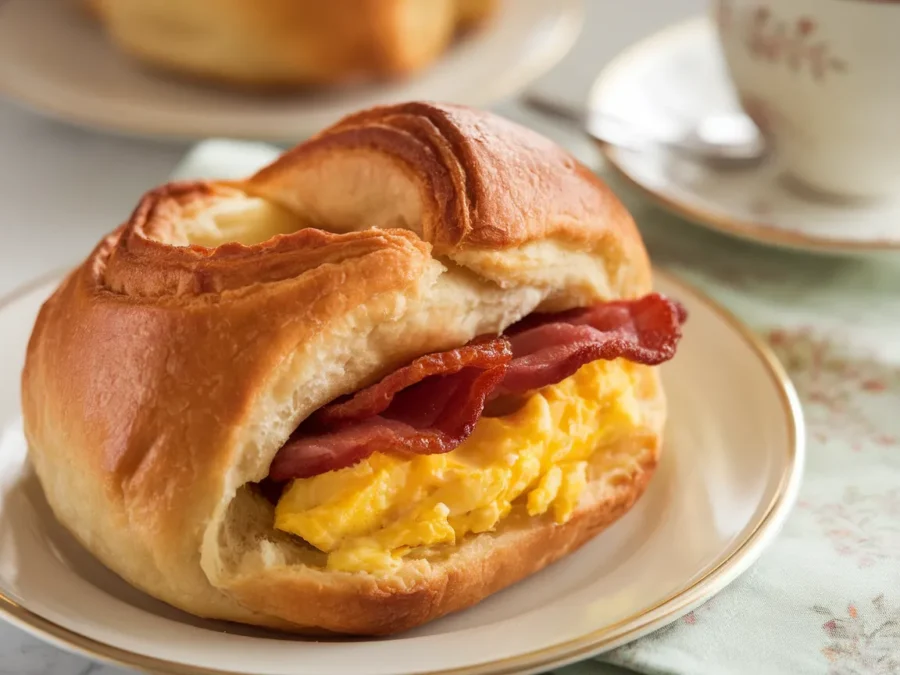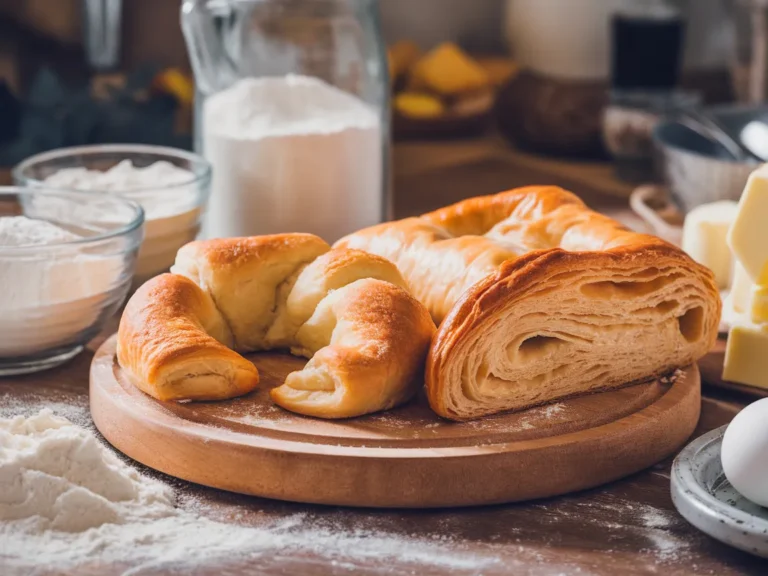Crescent rolls and puff pastry are two popular options in the world of baking, but they’re often confused for one another. Both have a rich, buttery taste and flaky texture, making them favorites for a variety of recipes. However, they are far from the same. If you’ve ever wondered, “Is crescent rolls puff pastry?”, this article is for you. Here, we’ll explore what sets these two apart, when you can substitute one for the other, and how to elevate your baking game using crescent rolls or puff pastry. Let’s dive into the delicious details.
Table of Contents
What Are Crescent Rolls and Puff Pastry?
What Are Crescent Rolls?
Crescent rolls are a type of enriched dough that’s known for its soft, buttery flavor and slightly flaky texture. The dough is typically made with ingredients like flour, butter, sugar, and milk, giving it a tender, slightly sweet taste. Crescent rolls are pre-packaged and shaped into triangles, which makes them super convenient for home bakers.
Historically, crescent rolls trace their origins back to Austria, where the kipferl (a crescent-shaped pastry) was first created. Today, they’re best known as a household staple, especially in the form of Pillsbury crescent rolls, which have made quick, homemade pastries a breeze.
What Is Puff Pastry?
Puff pastry, on the other hand, is a more intricate and delicate pastry dough. It’s made by folding butter into dough through a process known as lamination. This creates multiple thin layers of dough and butter, resulting in the signature flakiness. When baked, puff pastry rises dramatically, creating a light, airy texture that’s perfect for both savory and sweet recipes.
Unlike crescent rolls, puff pastry has a more neutral taste, allowing it to pair well with both sweet fillings like fruit and savory ones like cheese or meat. This French culinary marvel has been a staple in bakeries and high-end recipes for centuries.
How Are Crescent Rolls and Puff Pastry Similar?
At first glance, it’s easy to see why people confuse crescent rolls with puff pastry. Both have a flaky texture, and both are made with butter as a key ingredient. They’re also versatile, appearing in recipes ranging from appetizers to desserts. However, while puff pastry relies on its layers to create a crispy bite, crescent rolls have a softer, bread-like structure. Despite their differences, both bring unique qualities to the table.
Key Differences Between Crescent Rolls and Puff Pastry
Difference in Dough Preparation
One of the biggest distinctions between crescent rolls and puff pastry lies in their dough preparation methods. Crescent roll dough is made using an enriched yeast dough, incorporating ingredients like butter, milk, and sugar. This creates a soft and slightly sweet bread-like texture. The dough is rolled into triangles, making it easy to shape into its signature crescent form.
On the other hand, puff pastry dough is a masterpiece of lamination. This technique involves folding and layering butter into the dough multiple times. The process is time-intensive but results in the thin, flaky layers puff pastry is famous for. Unlike crescent rolls, puff pastry does not contain yeast, relying entirely on steam to rise during baking.
Difference in Texture and Taste
Texture is where these two pastries truly diverge. Puff pastry boasts a crispy, flaky bite due to its many layers. When you take a bite, the layers often shatter into delicious, buttery crumbs. Meanwhile, crescent rolls are softer and more bread-like, with a hint of chewiness.
Taste is another differentiator. Puff pastry is more neutral, making it suitable for a range of sweet and savory dishes. In contrast, crescent rolls have a slightly richer flavor, thanks to the added sugar and milk in the dough. This sweetness complements breakfast spreads and desserts beautifully.
Difference in Culinary Uses
The choice between crescent rolls and puff pastry often depends on the recipe. Puff pastry is the go-to option for recipes that require a delicate, airy texture, like tarts, vol-au-vents, and turnovers. Crescent rolls shine in simpler, home-style dishes, such as pigs in a blanket or stuffed rolls.
For example, puff pastry can elevate a dish like Beef Wellington, while crescent rolls work well in comforting casseroles or quick appetizers. Knowing their differences allows you to pick the right pastry for the dish you’re preparing.
Can Crescent Rolls Be Substituted for Puff Pastry?
When Crescent Rolls Can Be Used as a Substitute
If you’re out of puff pastry and wondering, “Is crescent rolls puff pastry?”, the answer is no but crescent rolls can still act as a substitute in certain recipes. For dishes that don’t rely on the crisp, flaky layers of puff pastry, crescent rolls can be a lifesaver. Savory pies, simple tarts, or hand pies work well with crescent roll dough.
To mimic puff pastry, roll out the crescent dough thinner and layer it slightly before baking. While the texture won’t be the same, this trick can add a touch of flakiness to your dish.
When Crescent Rolls Cannot Replace Puff Pastry
However, crescent rolls can’t replicate puff pastry in recipes requiring a specific flaky texture or structural integrity. Classic puff pastry dishes like mille-feuille or vol-au-vents won’t achieve their signature look or mouthfeel with crescent rolls. The lack of laminated layers in crescent rolls means they won’t puff up the same way.
Recipes like Beef Wellington or intricate pastry desserts require the crisp layers only puff pastry can deliver. In these cases, attempting to substitute crescent rolls would compromise the dish’s overall quality.
How to Level Up Crescent Rolls for Various Recipes
Enhancing Flavor with Fillings and Toppings
Crescent rolls are versatile, but you can make them even better with the right fillings and toppings. Whether you prefer sweet or savory dishes, there are countless ways to enhance their flavor. For breakfast, try stuffing your crescent rolls with cream cheese, scrambled eggs, or bacon for a hearty start to the day. Love sweets? Add a dollop of Nutella, fruit preserves, or cinnamon sugar before rolling them up.
Toppings can also transform crescent rolls into a gourmet treat. Brush them with garlic butter and sprinkle Parmesan for a savory twist, or glaze them with honey and crushed nuts for a dessert-like finish. By experimenting with fillings and toppings, you can elevate the humble crescent roll to something truly special.
Transforming Crescent Rolls into Gourmet Dishes
While crescent rolls are great on their own, they can also serve as a base for sophisticated dishes. Want to mimic puff pastry? Fold the dough into layers before rolling it out. This won’t create authentic lamination, but it adds a touch of flakiness. Use crescent rolls to make mini tarts, turnovers, or even pot pie crusts.
For example, you can use crescent rolls to create a quick and easy pastry braid filled with spinach and feta. Another idea is wrapping them around brie cheese for a warm, gooey appetizer. The possibilities are endless when you let your creativity take the lead.
For more inspiration on enhancing simple ingredients, check out the recipes featured on Tasty Sara’s site.
Substitutes for Crescent Rolls and Puff Pastry
What Are Common Substitutes for Crescent Rolls?
If you’re out of crescent rolls, don’t fret there are plenty of substitutes that work just as well. Biscuit dough is a popular option for recipes requiring a fluffy, tender texture. It’s easy to roll out and shape, making it suitable for savory recipes like pigs in a blanket.
Pie crust is another alternative, especially for recipes where a flaky texture is key. Though pie crust doesn’t puff up like crescent rolls, its buttery layers can mimic a similar taste. For a sweeter option, try cinnamon roll dough as a substitute for desserts.
Alternatives for Puff Pastry
When puff pastry isn’t available, consider phyllo dough as a substitute. While it doesn’t have the same puff, its thin, flaky layers make it ideal for tarts and savory pies. Biscuit dough can also work in a pinch, but it lacks the airy, crispy layers unique to puff pastry.
Another option is to make your own quick puff pastry at home. By folding butter into store-bought pie dough, you can create a semi-laminated effect that mimics puff pastry’s texture. This DIY method is perfect for those who want to replicate puff pastry without the long preparation time.
For more baking tips and tricks, explore related articles on Tasty Sara’s blog.
Recipes to Explore Using Crescent Rolls and Puff Pastry
Quick and Easy Recipes with Crescent Rolls
Crescent rolls shine in quick recipes that don’t compromise on flavor. For breakfast, try making crescent roll quiches filled with eggs, cheese, and veggies. Another idea is crescent roll cinnamon bites just roll them in cinnamon sugar and bake for a sweet treat.
For dinner, crescent roll chicken pockets are a crowd-pleaser. Wrap the dough around shredded chicken, cream cheese, and spices, then bake until golden. These recipes prove that crescent rolls are perfect for everyday meals.
Elegant Recipes with Puff Pastry
Puff pastry, with its flaky layers, is ideal for elegant recipes. Sweet dishes like fruit-filled puff pastry tarts or chocolate éclairs make for stunning desserts. For savory options, Beef Wellington or cheese-filled pastry twists add a touch of sophistication to any dinner.
If you’re asking “Is crescent rolls puff pastry?” these recipes highlight why the two aren’t interchangeable in many cases. Puff pastry delivers the delicate crispiness required for gourmet dishes, whereas crescent rolls excel in home-style meals.
For more creative recipe ideas, visit your favorite cooking blogs or explore options like savory pies and flaky desserts using both pastries.

Tips for Working with Crescent Rolls and Puff Pastry
Tips for Handling Crescent Rolls
Crescent rolls are a beginner-friendly dough, but a few tricks can make them even better. First, always keep the dough chilled until you’re ready to use it. Warm dough can become sticky and hard to handle. When rolling out crescent rolls, use a light touch to avoid flattening the layers that contribute to their soft texture.
For recipes that require fillings, avoid overstuffing. Too much filling can cause the dough to tear or bake unevenly. If you’re wondering, “Is crescent rolls puff pastry?”, remember that crescent rolls don’t have the structural integrity of laminated dough, so be mindful of how you use them in layered dishes.
Tips for Handling Puff Pastry
Puff pastry is more delicate, so proper preparation is key. Always thaw frozen puff pastry in the refrigerator instead of at room temperature. This prevents the butter layers from melting before baking. When working with puff pastry, use a sharp knife to cut clean edges; this helps the dough puff evenly in the oven.
To maximize the rise, avoid pressing down on the edges of your pastry. The layered structure relies on steam to create that airy texture, and sealing the edges too tightly can hinder the process. For extra golden color and shine, brush the pastry with an egg wash before baking.
If you’re making a recipe that calls for puff pastry, such as turnovers or vol-au-vents, these tips will ensure professional-looking results every time.
FAQs About Crescent Rolls and Puff Pastry
What Do You Put on a Croissant for Breakfast?
Croissants are incredibly versatile, making them perfect for breakfast. If you’re looking for something sweet, try spreading jam, honey, or Nutella over your croissant. Pair it with a cup of coffee, and you’ve got a classic morning treat. For a more savory option, fill your croissant with scrambled eggs, bacon, or cheese.
If you’ve ever wondered “Is crescent rolls puff pastry?”, keep in mind that crescent rolls can also be customized for breakfast in much the same way. Try stuffing crescent rolls with cream cheese or ham to create a flaky breakfast option that’s quick and delicious.

How Do You Level Up Crescent Rolls?
Elevating crescent rolls is all about creativity. Start by adding fillings that complement your dish savory ingredients like spinach, feta, or smoked salmon can make crescent rolls dinner-party worthy. For desserts, fillings like chocolate chips or fruit preserves work wonders.
Another way to upgrade crescent rolls is by experimenting with shapes. Turn them into pastry braids, pinwheels, or pockets for an elegant touch. Brushing the tops with an egg wash and sprinkling sesame seeds, Parmesan, or sugar can also add texture and flavor.
What Is a Substitute for Crescent Roll Pastry?
If you’re out of crescent roll dough, other options can work in a pinch. Biscuit dough and pie crust are great substitutes for both sweet and savory recipes. If your recipe requires a soft, bread-like texture, opt for pizza dough instead. These alternatives may not replicate crescent rolls perfectly, but they can save your recipe.
Why Can’t Crescent Rolls Replace Puff Pastry in Certain Recipes?
The difference lies in the dough structure. Crescent rolls lack the laminated layers of puff pastry, which provide the signature airy, crisp texture. For recipes like turnovers or vol-au-vents, puff pastry is irreplaceable. However, for simpler dishes, crescent rolls can still be a convenient alternative.
Conclusion: Crescent Rolls and Puff Pastry in Your Kitchen
While crescent rolls and puff pastry share some similarities, they are distinct in their preparation, texture, and use. Crescent rolls are perfect for quick, comforting recipes, offering a soft and slightly flaky bite. Puff pastry, with its intricate layers and delicate crispiness, is the choice for elegant and sophisticated dishes. If you’ve ever asked yourself, “Is crescent rolls puff pastry?”, the answer lies in understanding these key differences.
Both types of dough have their place in the kitchen. Crescent rolls are ideal for casual meals, while puff pastry adds a touch of luxury to special occasions. By learning how to handle each one properly and knowing when to substitute, you can expand your baking repertoire and create dishes that suit any occasion.
So, whether you’re rolling up crescent rolls for a cozy family dinner or crafting puff pastry tarts for a holiday gathering, these versatile pastries will never disappoint. Experiment with recipes, try out substitutions, and let your creativity shine in the kitchen.
For more baking inspiration and recipe ideas, explore culinary blogs or experiment with these pastries in your favorite dishes. Crescent rolls and puff pastry might not be interchangeable, but each brings something unique to the table.

